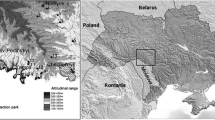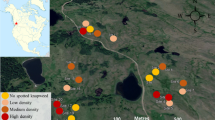Abstract
Data from remote sensing are often used as proxies to quantify biological processes, especially at large geographical scales. The normalized difference vegetation index (NDVI) is the most frequently used proxy for primary productivity. Assuming a direct, positive interrelation between primary and secondary production in terrestrial habitats, NDVI is often used to predict food availability for higher trophic levels. However, the relationship between NDVI and arthropod biomass has rarely been tested. In this study, we analyzed extensive datasets of arthropod communities from semi-natural grasslands in central Europe to test the relationship between arthropod biomass of consumer trophic levels (“herbivores,” “mixed,” and “carnivores”) in grassland communities and NDVI during the spring season. We found that arthropod biomass generally increased with NDVI. The same positive relationship between biomass and NDVI was observed for each individual trophic level. Cross-correlation analyses did not show statistically significant lags between the NDVI and biomass of herbivores and carnivores. All in all, our study provides correlational evidence for the positive relation of primary and secondary productivity in temperate terrestrial habitats during spring. Moreover, it supports the applicability of NDVI data as a suitable habitat-specific proxy for the food availability of insectivores during spring.


Similar content being viewed by others
Data availability
This study was a re-analysis of field data collected in the 1980s within the grassland project of the former Scientific Department Ecology (Wissenschaftsbereich Ökologie) at the Friedrich-Schiller-University Jena (former German Democratic Republic).
References
Apiwathnasorn C, Asavanich A, Komalamisra N, Samung Y, Prummongkol S, Kanjanopas K (2006) The relationship between the abundance of Mansonia mosquitoes inhabiting a peat swamp forest and remotely sensed data. SE Asian J Trop Med 37:463–467
Bell GP (1990) Birds and mammals on an insect diet: a primer on diet composition analysis in relation to ecological energetics. Stud. Avian Biol 13:416–422
Both C, Van Asch M, Bijlsma RG, Van Den Burg AB, Visser ME (2009) Climate change and unequal phenological changes across four trophic levels: constraints or adaptations? J Anim Ecol 78:73–83
Bravo C, Moshou D, West J, McCartney A, Ramon H (2003) Early disease detection in wheat fields using spectral reflectance. Biosyst Eng 84:137–145
Buler JJ, Moore FR, Woltmann S (2007) A multi-scale examination of stopover habitat use by birds. Ecology 88:1789–1802
Bundesamt für Naturschutz (2014) https://biologischevielfalt.bfn.de/nationale-strategie/indikatoren-und-berichterstattung/indikatorenbericht-2014/indikatoren/dauer-der-vegetationsperiode.html
Chan KS, Ripley B (2012) TSA: Time series analysis. R package version, 1: 22-1821.
Cole EF, Long PR, Zelazowski P, Szulkin M, Sheldon BC (2015) Predicting bird phenology from space: satellite-derived vegetation green-up signal uncovers spatial variation in phenological synchrony between birds and their environment. Ecol Evol 5:5057–5074
Crawley MJ (1983) Herbivory. University of California Press, Berkeley, CA, The dynamics of animal-plant interactions
Deveson ED (2013) Satellite normalized difference vegetation index data used in managing Australian plague locusts. J Appl Remote Sens 7:75–96
Fuller DO (1998) Trends in NDVI time series and their relation to rangeland and crop production in Senegal, 1987-1993. Int J Remote Sens 19:2013–2018
Gossner MM, Simons NK, Achtziger R, Blick T, Dorow WH, Dziock F et al (2015) A summary of eight traits of Coleoptera, Hemiptera, Orthoptera and Araneae, occurring in grasslands in Germany. Sci Data 2:150013
Grande JM, Serrano D, Tavecchia G, Carrete M, Ceballos O, Díaz-Delgado R, Tella JL, Donázar JA (2009) Survival in a long-lived territorial migrant: effects of life-history traits and ecological conditions in wintering and breeding areas. Oikos 118:580–590
Hamel S, Garel M, Festa-Bianchet M, Gaillard JM, Côté SD (2009) Spring Normalized Difference Vegetation Index (NDVI) predicts annual variation in timing of peak faecal crude protein in mountain ungulates. J Appl Ecol 46:582–589
Hutto RL (1985) Seasonal changes in the habitat distribution of transient insectivorous birds in southeastern Arizona: competition mediated? Auk 102:120–132
Jarošík V, Honěk A, Magarey RD, Skuhrovec J (2011) Developmental Database for Phenology Models: Related Insect and Mite Species have Similar Thermal Requirements. J Econ Entomol 104:1870–1876
Jepsen JU, Hagen SB, Høgda KA, Ims RA, Karlsen SR, Tømmervik H, Yoccoz NG (2009) Monitoring the spatio-temporal dynamics of geometrid moth outbreaks in birch forest using MODIS-NDVI data. Remote Sens Environ 113:1939–1947
Jonzén N, Hedenström A, Lundberg P (2007) Climate change and the optimal arrival of migratory birds. Proc Biol Sci 274:269–274
Kerby JT, Wilmers CC, Post E (2012) Climate change, phenology, and the nature of consumer–resource interactions: advancing the match/mismatch hypothesis. In: Ohgushi T, Schmitz O, Holt RD (eds) (2012) Trait-mediated indirect interactions: ecological and evolutionary perspectives. Cambridge University Press, Cambridge, UK, pp 508–525
Lassau SA, Hochuli DF (2008) Testing predictions of beetle community patterns derived empirically using remote sensing. Divers Distrib 14:138–147
Malt S, Perner J (2002) Zur epigäischen Arthropodenfauna von landwirtschaftlichen Nutzflächen der Unstrutaue im Thüringer Becken. Teil 1: Webspinnen und Weberknechte (Arachnida: Araneae et Opiliones). Faun Abh Mus Tierkd Dresden 22:207–228
Marshall HG, Nesius KK (1996) Phytoplankton composition in relation to primary production in Chesapeake Bay. Mar Biol 125:611–617
Mattson WJ (1980) Herbivory in relation to plant nitrogen content. Annu Rev Ecol Evol Sci 11:119–161
Mittelbach GG, Steiner CF, Scheiner SM, Gross KL, Reynolds HL, Waide RB, Willig MR, Dodson SI, Gough L (2001) What is the observed relationship between species richness and productivity? Ecology 82:2381–2396
Morse DH (1971) The insectivorous bird as an adaptive strategy. Annu Rev Ecol Evol Sci 2:177–200
Myneni RB, Hall FG, Sellers PJ, Marshak AL (1995) The interpretation of spectral vegetation indexes. IEEE Geosci Remote Sens Lett 33:481–486
Newton I (2004) Population limitation in migrants. Ibis 146:197–226
Perner J (1997) Zur Arthropodenfauna der Kalktrockenrasen im Mittleren Saaletal (Ostthüringen). Teil 1: Coleoptera, Diptera, Auchenorrhyncha, Saltatoria, Araneae. Faun Abh Mus Tierkd Dresden 21:53–90
Perner J, Malt S (2002) Zur epigäischen Arthropodenfauna von landwirtschaftlichen Nutzflächen der Unstrutaue im Thüringer Becken. Teil 2: Käfer (Coleoptera). Faun Abh Mus Tierkd Dresden 22:261–283
Perrins CM (1970) The timing of birds’ breeding seasons. Ibis 112:242–255
Pettorelli N, Ryan S, Mueller T, Bunnefeld N, Jędrzejewska B, Lima M, Kausrud K (2011) The normalized difference vegetation index (NDVI): unforeseen successes in animal ecology. Clim Res 46:5–27
Pinter PJ Jr, Jackson RD, Elaine EC, Gausman HW (1985) Sun-angle and canopy-architecture effects on the spectral reflectance of six wheat cultivars. Int J Remote Sens 6:1813–1825
R-Core Team (2018) R: A language and environment for statistical computing. R Foundation for Statistical Computing, Vienna
Ribas CR, Schoereder JH, Pic M, Soares SM (2003) Tree heterogeneity, resource availability, and larger scale processes regulating arboreal ant species richness. Austral Ecol 28:305–314
Rogers LE, Hinds WT, Buschbom RL (1976) A general weight vs. length relationship for insects. Ann Entomol Soc Am 69:387–389
Scurlock JM, Johnson K, Olson RJ (2002) Estimating net primary productivity from grassland biomass dynamics measurements. Glob Chang Biol 8:736–753
Smith SH, Steenhof K, McClure CJ, Heath JA (2017) Earlier nesting by generalist predatory bird is associated with human responses to climate change. J Anim Ecol 86:98–107
Stephens PA, Pettorelli N, Barlow J, Whittingham MJ, Cadotte MW (2015) Management by proxy? The use of indices in applied ecology. J Appl Ecol 52:1–6
Stinson CSA, Brown VK (1983) Seasonal changes in the architecture of natural plant communities and its relevance to insect herbivores. Oecologia 56:67–69
Sweet SK, Asmus A, Rich ME, Wingfield J, Gough L, Boelman NT (2015) NDVI as a predictor of canopy arthropod biomass in the Alaskan arctic tundra. Ecol Appl 25:779–790
Trierweiler C, Mullie WC, Drent RH, Exo KM, Komdeur J, Bairlein F et al (2013) A Palaearctic migratory raptor species tracks shifting prey availability within its wintering range in the Sahel. J Anim Ecol 82:107–120
Wang Q, Adiku S, Tenhunen J, Granier A (2005) On the relationship of NDVI with leaf area index in a deciduous forest site. Remote Sens Environ 94:244–255
Watson L, Dallwitz M (2015) British insects. http://delta-intkey.com. Version: 25th January 2015
Weiser RL, Asrar G, Miller GP, Kanemasu ET (1984) Assessing Biophysical Characteristics of Grassland from Spectral Measurements. Mach Process Remotely Sensed Data Symp 152:141–152
Wiegand T, Naves J, Garbulsky MF, Fernández N (2008) Animal habitat quality and ecosystem functioning: exploring seasonal patterns using Ndvi. Ecol Monogr 78:87–103
Author information
Authors and Affiliations
Contributions
All authors contributed equally to this work, including the conception, development, and writing of this manuscript.
Corresponding author
Ethics declarations
Within the temporal framework of the field work for this study, arthropod sampling had no legal restrictions in its location (former German Democratic Republic).
Conflict of interest
The authors declare that they have no conflict of interest.
Ethical approval
Not applicable.
Code availability
Code available on request from the authors.
Additional information
Communicated by: Matthias Waltert
Publisher’s note
Springer Nature remains neutral with regard to jurisdictional claims in published maps and institutional affiliations.
Electronic supplementary material
ESM 1
(PDF 436 kb)
Rights and permissions
About this article
Cite this article
Fernández-Tizón, M., Emmenegger, T., Perner, J. et al. Arthropod biomass increase in spring correlates with NDVI in grassland habitat. Sci Nat 107, 42 (2020). https://doi.org/10.1007/s00114-020-01698-7
Received:
Revised:
Accepted:
Published:
DOI: https://doi.org/10.1007/s00114-020-01698-7




